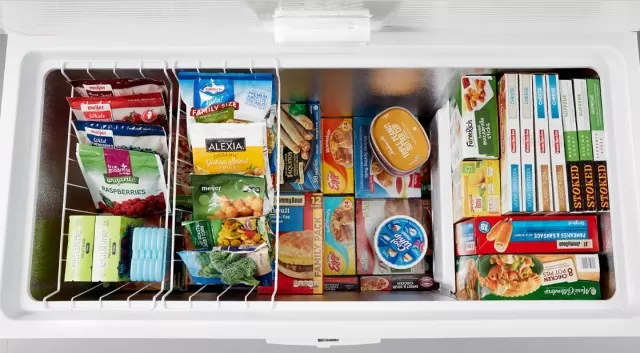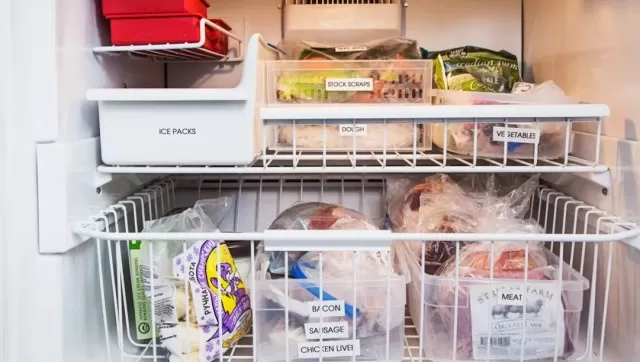Aside from the convenience, a well-organized Chest Freezer can also help you save money by taking advantage of sales and buying in bulk.
An additional freezer in your garage or basement can offer significant advantages.
Whether you’re hosting large gatherings or prefer to buy groceries in bulk, having extra freezer space provides convenience and flexibility. It allows you to store premade meals, frozen appetizers, or large quantities of food without worrying about limited space in your regular refrigerator freezer.
Aside from the convenience, a well-organized chest freezer can also help you save money.
By taking advantage of sales and buying in bulk, you can stock up on food items and ingredients while avoiding cluttering your main freezer. However, it’s important to remember that frozen foods have expiration dates, and a disorganized chest freezer can lead to food waste.
Without proper organization and tracking, it’s easy to overlook items that may go bad over time.
If your Deep Freezer needs decluttering, don’t worry.
Chest Freezer vs Deep Freezer

A chest freezer, often referred to as a deep freezer, differs from an upright freezer in several ways.
One notable distinction is the design of the door and the way you access the stored items. Chest freezers typically have a top-opening door that requires you to reach down into the unit to retrieve food items.
On the other hand, upright freezers have a vertical door that opens from the side, allowing you to access the items on shelves while standing.
In terms of storage capacity, chest freezers often provide more usable space compared to upright freezers of the same size.
The chest freezer’s design allows for efficient use of the internal space, as there are no shelves or compartments that may limit the storage of larger or irregularly shaped items. This makes chest freezers ideal for storing bulk food items, large cuts of meat, or frozen goods that don’t require frequent access.
On the other hand, upright freezers offer the advantage of better organization and visibility of the stored items.
With shelves and door storage compartments, it’s easier to categorize and access different types of food. Upright freezers are especially convenient for those who prefer a more traditional refrigerator-style layout and need frequent access to a variety of frozen foods.
When deciding between a chest freezer and an upright freezer, consider your specific needs, available space, and storage preferences.
Whether you prioritize maximum storage capacity or organized accessibility, both types of freezers have their benefits and can effectively meet your freezing requirements.
Chest Freezer Organization 5-Step Guide

Follow these simple steps to organize your chest freezer efficiently and quickly, ensuring that you can locate items and make the most of the available space.
Streamline Your Deep Freezer.
Simplifying the contents of your deep freezer doesn’t have to be a time-consuming task.
Approach it as a necessary step to ensure an organized and efficient storage space.
Prepare a nearby surface or a folding table by placing a towel or two, and begin by emptying the entire contents of the freezer.
Examine each item and discard anything that has expired, shows signs of freezer burn, or is of uncertain quality. Continue this process until you are left with only the food that is still good to consume.
Categorize Your Foods.
After decluttering, the next step is to sort your freezer foods.
Create categories based on food types, such as meats, fruits, vegetables, prepared meals (you can further separate homemade and store-bought if desired), items for children, and frozen treats like ice cream and pizza. This sorting process will not only give you an overview of your inventory but also help you establish designated zones within your deep freezer.
Utilize Containers for Organization.
Now it’s time to tap into your inner Marie Kondo and employ containers for efficient organization.
Remember that while the appearance of the containers is not crucial since the deep freezer is not on display, the durability of the material is essential.
While cardboard boxes might seem like a convenient option, they tend to weaken and disintegrate when exposed to moisture.
Opt for sturdy plastic baskets or search for containers specifically designed for fridge and freezer use, such as stackable acrylic bins. Another eco-friendly option is to use reusable silicone bags, which offer enhanced durability and airtight sealing, reducing plastic waste.
If you choose to use bags, store them upright in a bin to prevent them from getting lost in the freezer.
Ensure that the containers you select allow for clear visibility of the contents and maintain separate zones within your freezer.

Label Everything for Clarity.
Labeling is a crucial step, especially when items are stacked vertically in a deep freezer.
This practice prevents confusion later on about the contents of each container. Consider labeling not only the contents but also the expiration date or the date the item was prepared.
Permanent markers work well for marking one-time-use bags, while moisture-resistant label stickers can be affixed to reusable bins.
Maintain an Inventory and Regularly Update It.
For even more efficient deep freezer organization, consider keeping an inventory of the items inside along with important details such as expiration dates and cooking instructions.
This can be done using an electronic spreadsheet or by maintaining a physical list on a clipboard that can be hung near the freezer. By doing so, you reduce the risk of forgetting what you have stored and ensure that you use the items before they expire.
By following these steps and implementing effective organizational strategies, you can maintain a well-organized deep freezer that allows for easy access to your frozen foods and reduces the likelihood of waste or forgotten items.
*The information is for reference only.